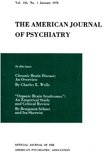Abstract
General characteristics of 270 sexual psychopaths, studied at the 36th Station Hospital (NP) are presented on a statistical. basis. Outstanding features:
a. The problem of sexual psychopathy in the military service is essentially that of homosexuality. Cases of other forms of sexual psychopathy are numerically infrequent.
b. Feigning homosexual traits in order to avoid military obligations is not a serious problem in this theater. Careful study of 100 soldiers who applied for hospitalization revealed that paractically all were true homosexuals.
c. There has been lack of uniformity in medico-legal handling of these cases. There is considerable variation in attempting to decide which cases to try by court-martial, the severity of the sentences and the handling of clemency. In general, cases with single offenses, in men of good repute and honorable service, are more often prosecuted and receive more severe sentences than chronic offenders. Since the publication of War Department Circular No. 3, 3 January 1944, there has been more uniformity.
d. There is less reported homosexuality among colored troops than white.
e. The sexual psychopath is largely derived from urban areas.
f. Broken homes form the background of 41% of the sexual psychopaths. This figure is unusually high and is of significance.
g. Homosexuals are predominantly skilled and semi-skilled workers. Less than 2% are classified as unskilled.
h. The average mental age of homosexuals is well above the average for the Army. Only 9% are below the 12 year level; 79% are normal or higher. More than 50% score above 110 in the army AGCT test. There were no illiterates in the entire group studied.
i. The educational level was higher than in the Army in general; 86% had finished the 8th grade, 54% had graduated from high school.
j. Forty percent of the group gave a history of psychoses, chronic alcoholism or neuroses in the immediate family.
k. Neuroses were found present in 35% of the homosexual group, but were sufficiently disabling to require previous treatment in only 7%.
l. Homosexuals are in general a law abiding group. Arrests for minor or serious offenses are infrequent.
m. Homosexuals are likely to use alcohol to excess ; 35% were considered excessive drinkers, only 16% were abstainers. However only 2% were considered chronic alcoholics.
n. Drug addiction is infrequent among this group of sexual psychopaths.
o. The accident and illness rate of the group is very low. Their health record is impressive.
p. Fifteen percent of the homosexual group have had venereal diseases prior to or at their time of admission.
q. Forty-seven percent of the male homosexuals were considered to be feminine in general appearance, make up and temperament.
r. The group held higher ratings than the average of the Army : 10 master sergeants, 6 technical sergeants, 19 staff sergeants are among the list. Many ratings were based upon the possession of considerable talent in clerical, musical and dramatic ability.
s. Temperament and skills necessary to the combat soldier were infrequently seen.
Recommendations based on the above conclusions are submitted. The author does not believe that sodomy per se should be a punishable offense, that discharge from the military is necessary for most cases, or that deferment in the draft is advisable in all known cases. A large percentage of homosexuals possess sufficient restraint and insight, and have sufficient talents to justify careful examination of the individual case.
The opinions contained herein are those of the writer and are not offered in any official capacity.

